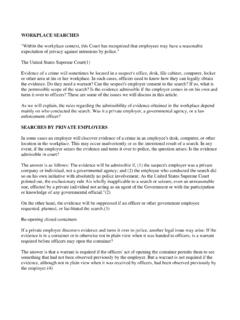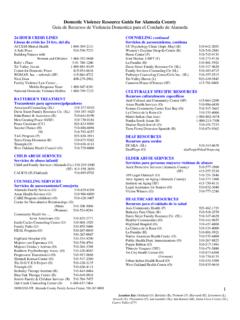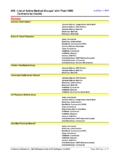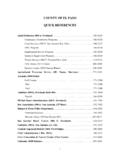Transcription of Searches Incident to Arrest - Home - Alameda …
1 1 POINT OF VIEWW inter 2011 Searches Incident to ArrestEvery Arrest must be presumed to presenta risk of danger to the arresting custodial Arrest of a suspect based on prob-able cause is a reasonable intrusion under theFourth Amendment; that intrusion being law-ful, a search Incident to the Arrest requires noadditional justification. It is the fact of thelawful Arrest which establishes the authority on this subject a few years ago, we happilymentioned in passing that this was an area of thelaw in which the courts had provided officers andprosecutors with rules that were easy to understandand apply.
2 We had no idea that a sudden anddramatic upheaval was Clarity To PerplexityBecause the circumstances surrounding most ar-rests are fluid, unpredictable, and dangerous, thecourts have long understood that the rules pertain-ing to Searches Incident to Arrest needed to be easilyapplied and predictably enforced. 7 And so, in 1969the United States Supreme Court ruled in the land-mark case of Chimel v. California that officers whohave made a custodial Arrest may, as a matter ofroutine, search those places and things over whichthe suspect had immediate control. 8 The Court also broadly defined the term immedi-ate control to encompass the area from withinwhich [the arrestee] might gain possession of aTmany of today s felons are not only violent and wellarmed, they are often desperate.
3 After all, they knowthey may be facing a lengthy prison term thanks tothe various sentencing enhancements for felonies inCalifornia, including the three strikes even when the crime was not a high-stakesfelony, there is always a threat of violence becausepeople who are about to lose their freedom even fora short time may act impulsively and attemptactions which are unlikely to succeed. 3 Taking noteof this, the United States Supreme Court pointed outthat [t]here is no way for an officer to predictreliably how a particular subject will react to Arrest orthe degree of the potential danger.
4 4 Or, as the NinthCircuit aptly observed, It is a difficult exercise at bestto predict a criminal suspect s next move. 5To help reduce these dangers, and also to make itharder for arrestees to destroy evidence, the Court ruled that officers who have made acustodial Arrest may, as a matter of routine, conducta type of search known as a search Incident to the Court:aking a suspect into custody is an extremely tense and risky undertaking. 2 This is espe-cially true when the crime is a felony because1 Washington v. Chrisman (1982) 455 1, State v. Murdock (Wis. 1990) 155 217, v.
5 McConney (9th Cir. 1984) 728 1195, Washington v. Chrisman (1982) 455 1, v. Reilly (9th Cir. 2000) 224 986, United States v. Robinson (1973) 414 218, 235. Edited. ALSO SEE Washington v. Chrisman (1982) 455 1, 7 [ an arrestingofficer s custodial authority over an arrested person does not depend upon a reviewing court s after-the-fact assessment of theparticular Arrest situation ]; United States v. Chadwick (1977) 433 1, 15 [officers are not required to calculate the probabilitythat weapons or destructible evidence may be involved ]; v. Osife (9th Cir. 2004) 398 1143, 1145 [ [C]ourts are not to decideon a case-by-case basis whether the arresting officers safety is in jeopardy or whether evidence is in danger of destruction.]
6 ]. NOTE:In some older California cases the courts ruled that officers could conduct a search Incident to Arrest only if they had probable causeto believe they would find a weapon or evidence. See, for example, People v. Flores (1979) 100 221, 229. Those rulingswere abrogated by Proposition 8. See In re Demetrius A. (1989) 208 1245, New York v. Belton (1981) 453 454, 459. ALSO SEE Dunaway v. New York (1979) 442 200, 213-14 [officers need [a]single, familiar standard ].8 (1969) 395 752, 763. ALSO SEE Michigan v. Long (1983) 463 1032, 1049, [ [P]art of the reason to allow areasearches Incident to an Arrest is that the arrestee, who may not himself be armed, may be able to gain access to weapons to injureofficers or others nearby, or otherwise to hinder legitimate police activity.
7 ]. Alameda county DISTRICT ATTORNEY S OFFICE2weapon or destructible evidence. 9 (Today, thissearchable area has become popularly known as grabbing space or grabbing radius. 10) In ex-plaining why it decided not to restrict these searchesto explorations of the arrestee s person, the Courtpointed out that [a] gun on a table or in a drawerin front of one who is arrested can be as dangerousto the arresting officer as one concealed in theclothing of the person arrested. In the following years, many of the lower courtsreached the conclusion that it would be unwise tostrictly interpret the terms immediate control and grabbing space to cover only those places andthings to which the arrestee had actual control at thetime of the search.
8 This was because such an interpre-tation would produce two troublesome , an arrestee who did not want officers tosearch a place or thing in his immediate controlwhen officers sought to Arrest him would be given apowerful incentive to break away from the officersand separate himself from it, even a short , officers who have arrested a suspect willoften have significant safety reasons for restrainingthe arrestee or moving him a short distance awaybefore searching those things that were under hiscontrol when he was arrested. For this reason, thecourts would consistently rule that it would beimprudent to require that officers choose betweenconducting a search and taking reasonable safetyprecautions.
9 Thus, comments such as the followingwould regularly appear in the cases: [I]t does not make sense to prescribe a consti-tutional test that is entirely at odds with safe andsensible police procedures. 11 [I]t makes no sense to condition a search inci-dent to Arrest upon the willingness of police toremain in harms way while conducting it. 12 [I]f the police could lawfully have searched thedefendant s grabbing radius at the moment ofarrest, he has no legitimate complaint if, thebetter to protect themselves from him, they firstput him outside that radius. 13 But one type of Arrest situation remained prob-lematic: Searches of vehicles Incident to the Arrest ofthe driver or other occupant.
10 The problem was thatthese arrestees were almost always restrained insome manner outside the vehicle before the searchbegan; , handcuffed, surrounded by officers,locked in a patrol car. Consequently, some courtswould rule that officers could not search the passen-ger compartment in these situations, while otherswould rule they could because, again, if somethingcould have been searched legally one minute, itseems irrational to rule it could not be searched afew seconds later because the officers had takenreasonable safety dilemma was finally resolved by the UnitedStates Supreme Court in 1981.










